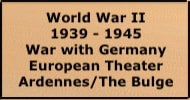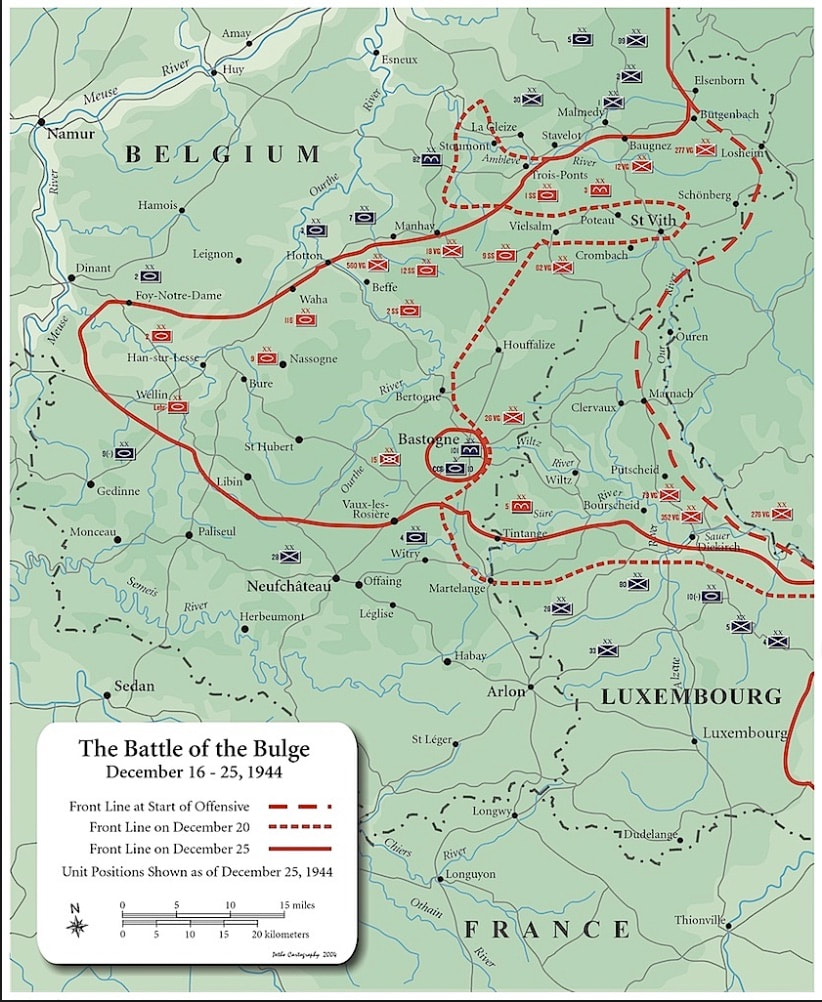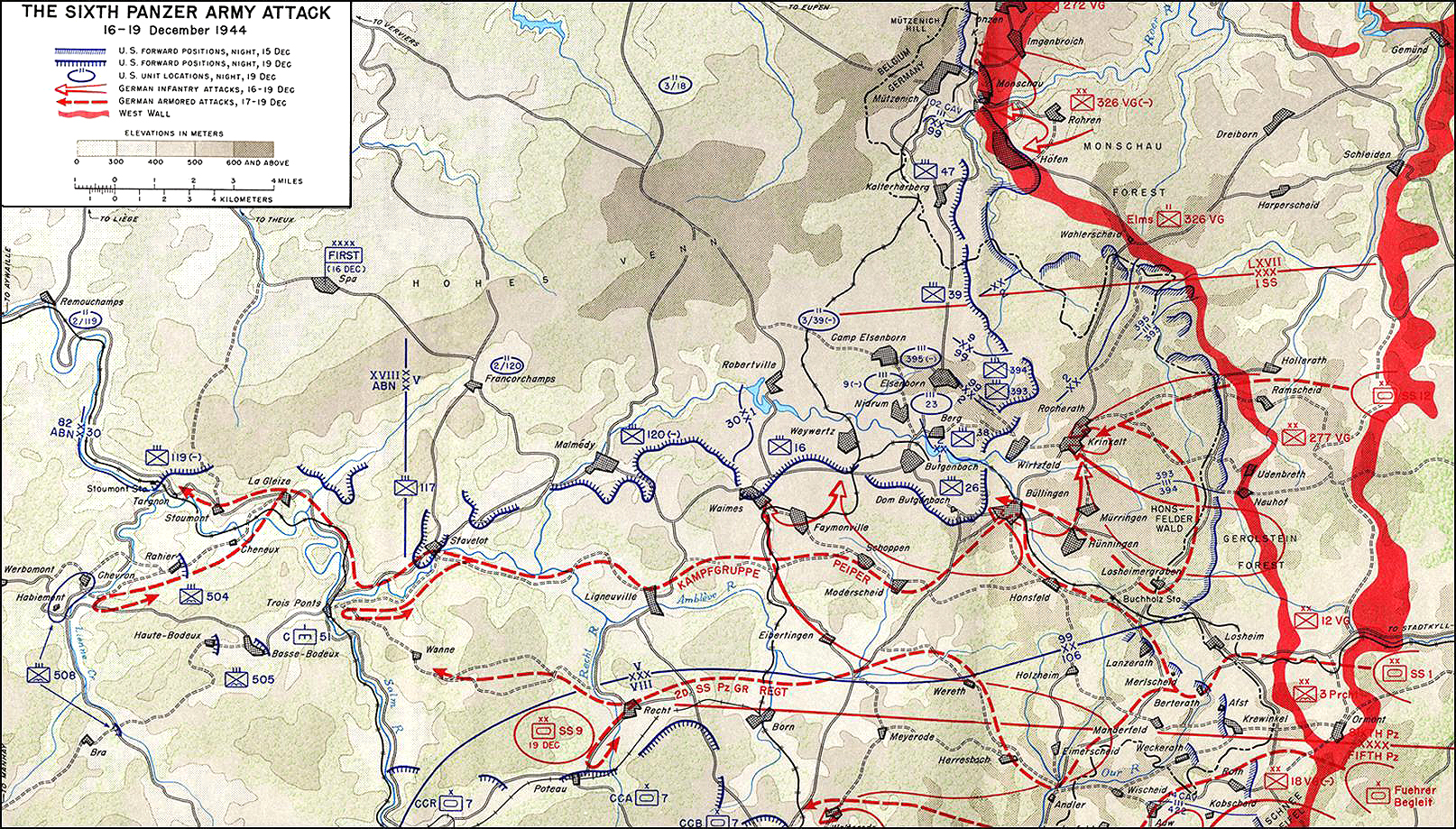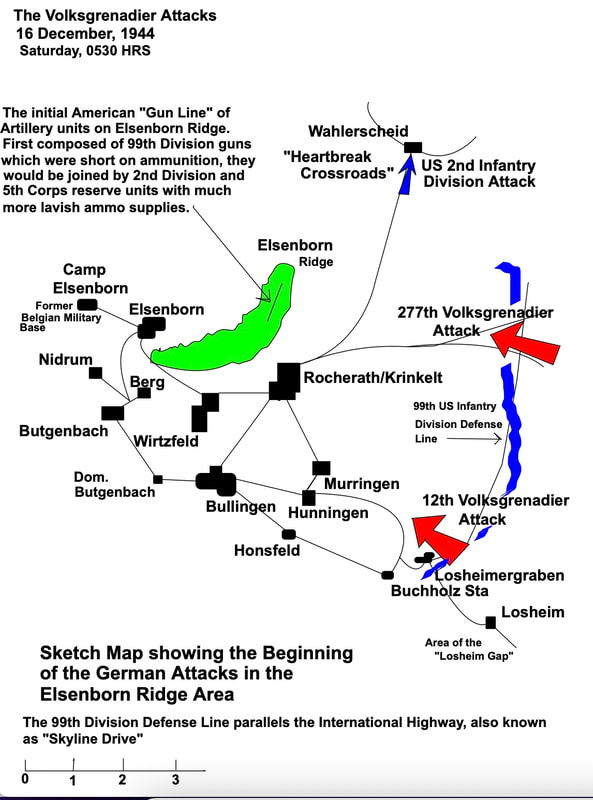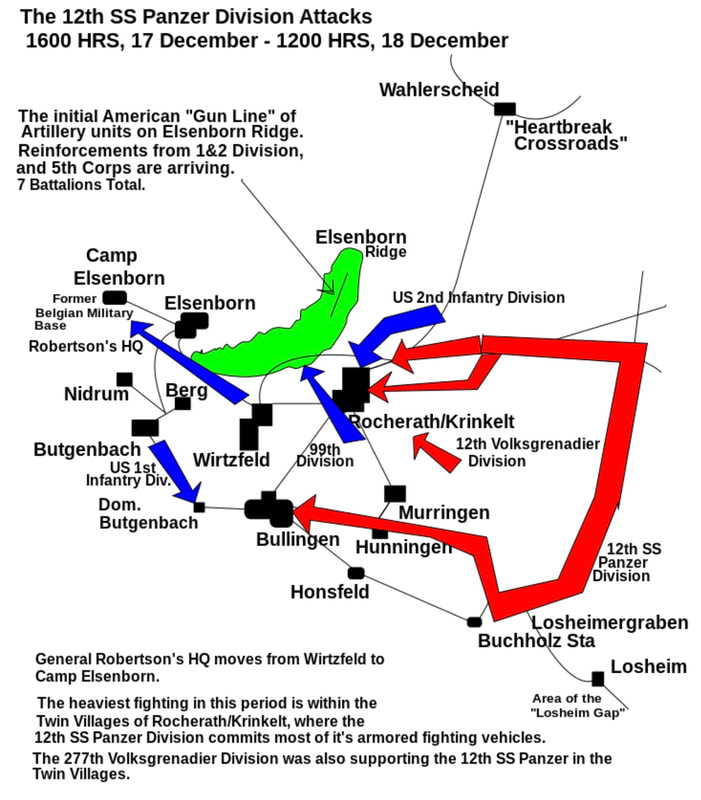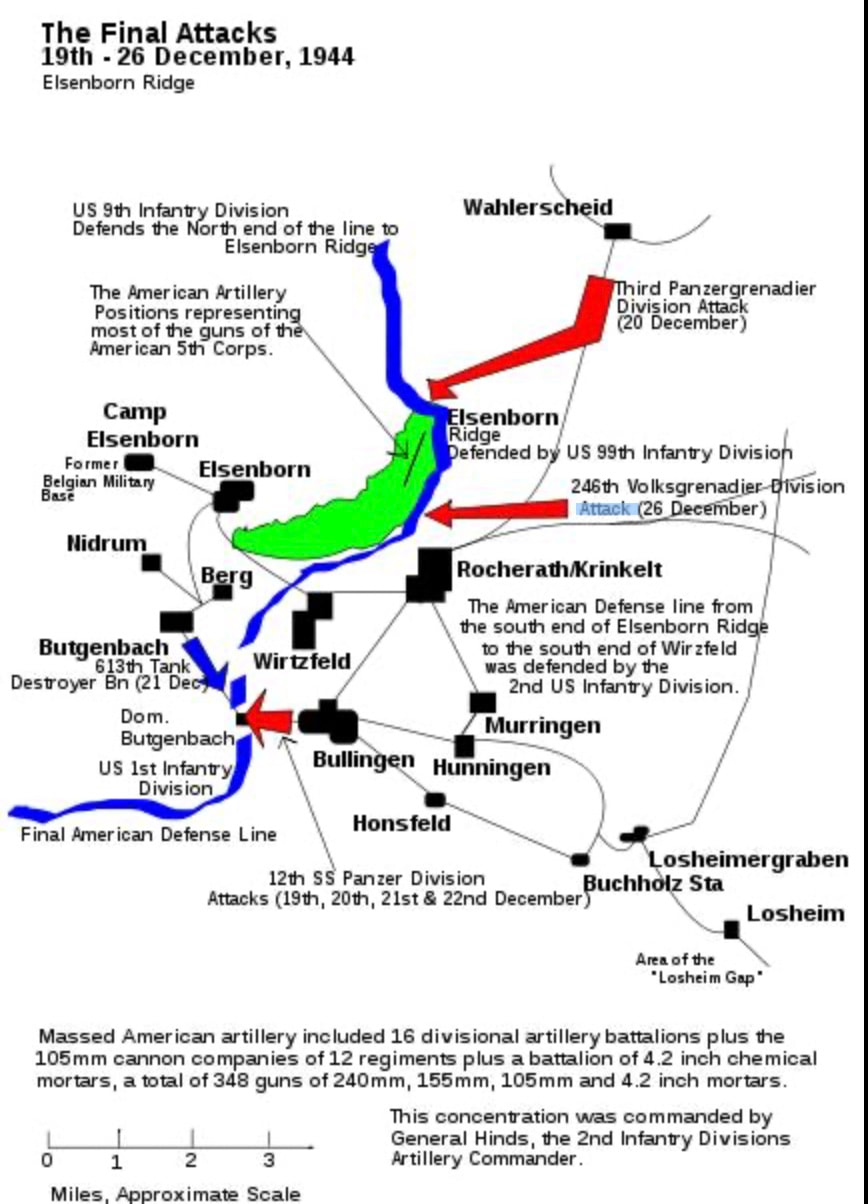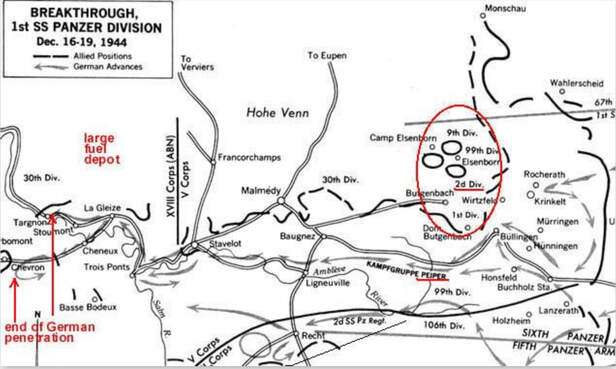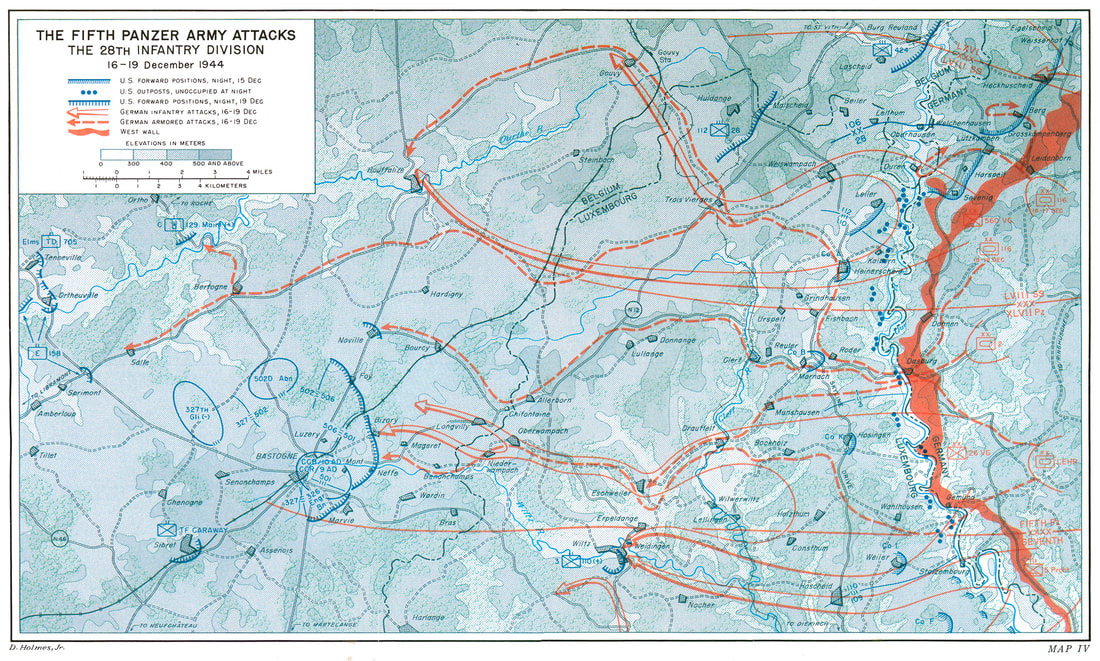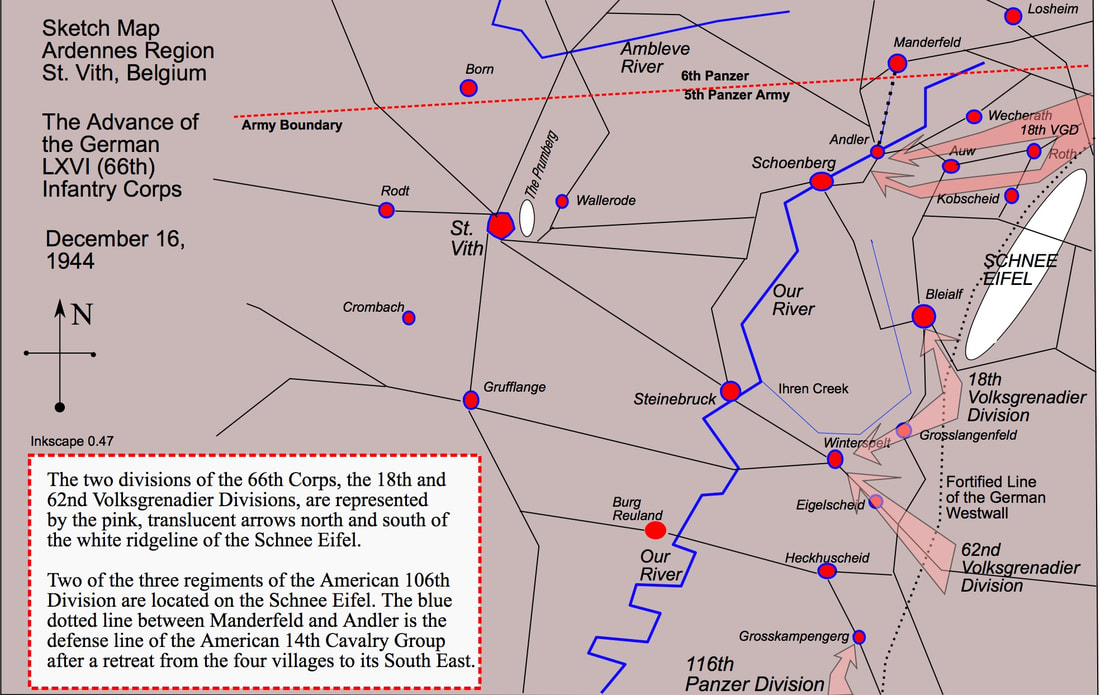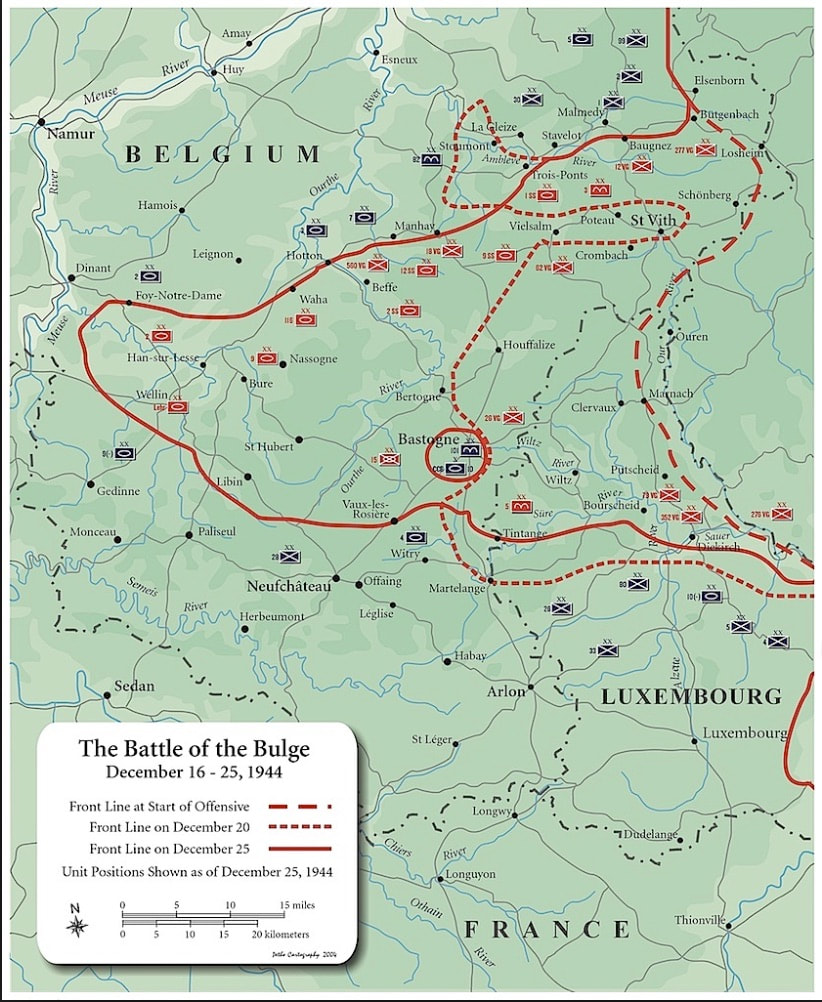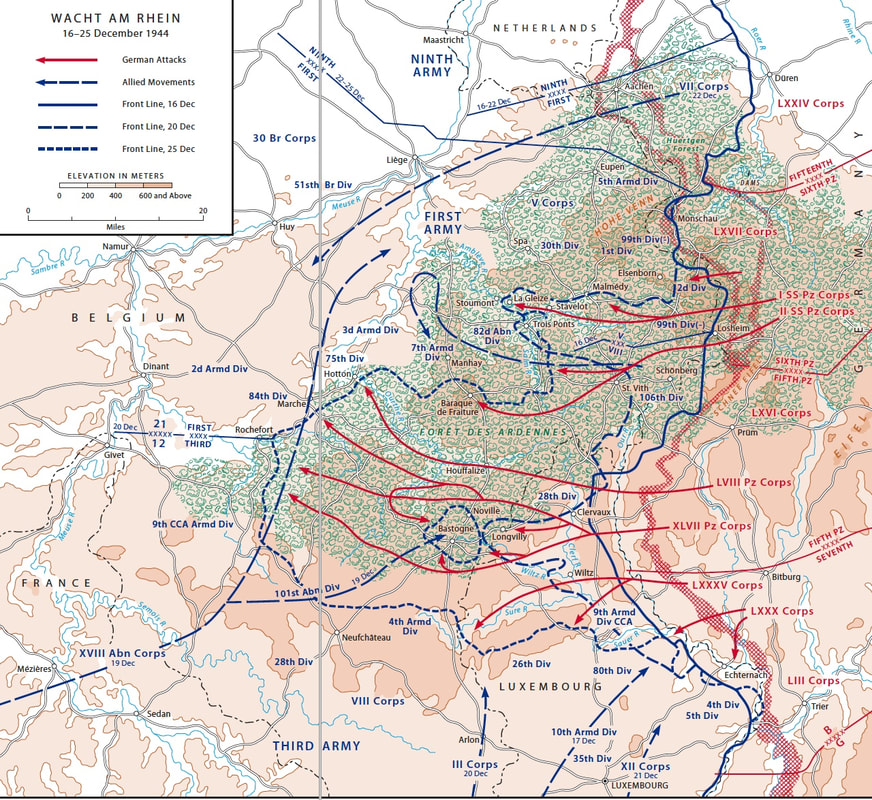bigpigeon.us webpage WWII Germany > The ETO > Ardennes/The Bulge > The Bulge Begins, © 2023 by Robert A. Christiansen, updated by RAC 4 Oct 2022.
Incomplete.
16-20 December 1944
During the first five days of the Ardennes counteroffensive, Wehrmacht forces smashed westward into the US First Army, pushing back the V Corps, and penetrating portions of the weakly-defended lines of VIII Corps.
Incomplete.
16-20 December 1944
During the first five days of the Ardennes counteroffensive, Wehrmacht forces smashed westward into the US First Army, pushing back the V Corps, and penetrating portions of the weakly-defended lines of VIII Corps.
The three armies of the Wehrmacht's Army Group B attacked on a wide front, as shown on the following map. (The northernmost attack, near Monshau and the southernmost, at Echternach, are shown with today's connecting road on an alternative map).
|
Saturday, 16 December was marked by congestion on the major German invasion route through the Losheim gap and confusion at US headquarters.
The Wehrmacht's Kampfgruppe Peiper, charged with racing to the Meuse River at Hoy as quickly as possible, was unable to begin until late afternoon. Nevertheless, in the next few days it penetrated deeply to the west before being cut off. Germany artillery damage to US telephone lines, plus poor radio reception in the Ardennes, generated confusion at US headquarters from the division level on up. On 17 December, having a clearer picture of scope of the Wehrmacht attack, reserve US units began to move towards the front. |
The Northern Sector, V Corps versus the Sixth Panzer Army
|
Only in the north, where elements of the Sixth Panzer Army attacked V Corps positions, were US positions stable at the end of the first five days.
The accompanying map illustrates three aspects of this stage of the Battle of the Bulge, none of which worked according to Wehrmacht plans:
After the first five days of combat, Sixth Panzer Army could no longer fulfill its mission of crossing the Meuse River and advancing to Antwerp. |
|
The Defense of Monshau against the Wehrmacht's LXVII Corps
The Monshau area on the north was defended by the 14th Cavalry Group and elements of the green 99th Infantry Division. The attacking force, two infantry divisions comprising the Wehrmacht's LXVII Corps, had been disorganized by the unexpected last-minute need to clear the 79th Infantry division from its route. LXVII Corps attacked at under half-strength for three days, December 16, 17 and 18. US forces, relatively equal in strength, held fast.
This was a major blow to German plans, as LXVII Corps' mission including advancing northward ten miles to the road center of Eupen on the first day, thus severing the key routes for US reinforcements coming from the Ninth Army and First Army's VII Corps in the north.
This was a major blow to German plans, as LXVII Corps' mission including advancing northward ten miles to the road center of Eupen on the first day, thus severing the key routes for US reinforcements coming from the Ninth Army and First Army's VII Corps in the north.
The Battle of Elsenborn Ridge
V Corps' southern sector, although hit hard by the Wehrmacht attack, was able to stage a fighting retreat of five to ten miles to Elsenborn Ridge, shown on the three maps below. The first US reinforcements arrived from the north late on 17 December. Subsequently reinforcements, especially artillery, continued to arrive.
US forces beat back repeated Wehrmacht assaults, losing perhaps 5,000 dead in the process. The retention of Elsenborn Ridge constrained the Sixth Panzer Army to roadways inadequate to support a major advance to the Meuse and onward to Antwerp.
US forces beat back repeated Wehrmacht assaults, losing perhaps 5,000 dead in the process. The retention of Elsenborn Ridge constrained the Sixth Panzer Army to roadways inadequate to support a major advance to the Meuse and onward to Antwerp.
The Rampage of Kampfgruppe Peiper
|
The mission of Kampfgruppe Peiper, a major component of the 1st SS Panzer Division, was to move westward with all possible speed, seizing a crossing - or maybe two - across the Meuse River.
Peiper was delayed on 16 December due to road congestion. On the 17th, Kampfgruppe Peiper sped westward, striking the southern end of V Corps, killing some hundreds of Americans, and terrorizing hundreds more who fled west in any available vehicle. Fuel shortages, road blocks, and opposition from 30th and 82nd Division units kept Peiper far from his goal. Out of gas, Peiper abandoned his vehicles, his wounded, his prisoners (those who hadn't been shot after surrendering), and with under 1,000 men walked southeast to the nearest Wehrmacht position. |
The Southern Section, VIII Corps versus the Fifth Panzer Army
|
The two US infantry division in VIII Corps that felt the brunt of the Wehrmacht attack suffered different fates:
|
The Fall of the 106th Infantry Division
|
The green 106th Infantry Division replaced the 2nd Infantry Division in the northern portion of the First Army's VIII Corps sector around 10 December. Two regiments of the 106th, the 422nd and 423rd, were stationed east of the Our River near the west side of the Schnee Eifel ridge; the third regiment, the 424th, was several miles to the southwest on the west side of the Our. Division headquarters was at St. Vith.
The 422nd and 423rd regiments came under artillery fire early on 16 December and hunkered down rather than withdraw from their vulnerable positions. By 17 December, when a withdrawal was attempted, they were surrounded. They surrendered on the 19th, losing over 6,000 men to the German prison camps. The remainder of the 106th Division then participated in the defense of the road junction of St. Vith to the west. |
|
The first accompanying map shows the German Ardennes counteroffensive progressing, from the US front lines early on 16 December, then on 20 December, and then on 25 December, when the Bulge was near its maximum.
After the attack began, both parties fed additional divisions into the combat zone, as shown on the first map. For more information about US units in the Battle of the Bulge, see The ETO > ETO Overview > ETO Orders of Battle > Ardennes 25 December 1944. Bulge Timeline 16-20 December 16 December:
|
Ten or eleven days passed before the Wehrmacht advance was halted. It took an additional month for US forces to eliminate the Bulge.
Neither the grandiose German goal of advancing to Antwerp and splitting the Allied forces nor a more moderate goal of breaching the Meuse River was realized. The result was an American strategic victory. The German army lost valuable reserves and were eventually forced to withdraw. However, Allied losses in men and material were roughly the same as German losses.
As collateral damage, around 3,000 civilians were killed during the Battle of the Bulge, including 22 mostly women and children taken from a cellar and shot by the SS in Stavelot.
Neither the grandiose German goal of advancing to Antwerp and splitting the Allied forces nor a more moderate goal of breaching the Meuse River was realized. The result was an American strategic victory. The German army lost valuable reserves and were eventually forced to withdraw. However, Allied losses in men and material were roughly the same as German losses.
As collateral damage, around 3,000 civilians were killed during the Battle of the Bulge, including 22 mostly women and children taken from a cellar and shot by the SS in Stavelot.
Sources for Big Pigeon's The ETO > Ardennes/The Bulge > The Bulge Begins webpage:
General sources for the Ardennes/The Bulge webpages: (C/O = courtesy of)
Pottawattamie Area WWII Dead - The ETO > Ardennes/The Bulge > The Bulge Begins:
† Anderson, Myron Bernell, SN 37-663-577, US Army, Clayton Co.
General sources for the Ardennes/The Bulge webpages: (C/O = courtesy of)
- http://www.ibiblio.org/hyperwar/USA/USA-E-Ardennes/index.html - The Ardennes: Battle of the Bulge (from the United States Army in World War II, European Theater of Operations series, by Hugh M. Cole).
- https://history.army.mil/catalog/pubs/72/72-26.html - Ardennes-Alsace (brochure from Campaigns of World War II: A World War II Commemorative Series, by Roger Cirillo).
- Ardennes-Alsace Brochure - This is Big Pigeon's copy of the above, provided for faster loading.
- Printable Timeline with Situation Maps, https://www.loc.gov/collections/world-war-ii-maps-military-situation-maps-from-1944-to-1945/articles-and-essays/the-battle-of-the-bulge/printable-timeline/ - C/O Library of Congress, loc.gov. This timeline depicts the key events of "The Battle of the Bulge" which took place in northern France over the course of December 16, 1944 to January 18, 1945 as told through the daily situation maps made for the US Military VIII Corps.
- https://en.wikipedia.org/wiki/Battle_of_the_Bulge - long article with a few good maps.
- http://www.historyofwar.org/articles/battles_bulge.html - good overview but a number of minor errors.
- https://en.wikipedia.org/wiki/Battle_of_the_Bulge_order_of_battle - detailed order of battle for an unspecified date late in the battle.
- Battle of St. Vith, https://en.wikipedia.org/wiki/Battle_of_St._Vith. The majority of this long article relates to The Fall of the 106th Infantry Division.
- The three elegant maps of the Battle for Elsenborn Ridge maps are by Frank done in 2010 using Inkscape, and were found in commons.wikipedia.org.
- Wehrmacht attacks in the 106th Division Sector, 16 December 1944, map, en.wikipedia.org/wiki/Battle_of_St._Vith#/media/File:St_Vith_Map_Ardennes.svg.
- Battle of the Bulge Overview - Positions, map, http://www.historynet.com/wp-content/uploads/image/2015/special-features-2015/map-battle-of-the-bulge-dec-16-25-1944.jpg.
- Battle of the Bulge Overview - Movement, map from pp. 26-27 of Ardennes-Alsace, the US Campaigns of WWII.
- Ardennes Landscape near Stavelot - photo - https://www.dreamstime.com/photos-images/belgian-ardennes.html.
Pottawattamie Area WWII Dead - The ETO > Ardennes/The Bulge > The Bulge Begins:
- Taken from the bigpigeon.us WWII Dead module.
† Anderson, Myron Bernell, SN 37-663-577, US Army, Clayton Co.
- Antitank Co., 424th Inf. Regt., 106th Inf. Div., VIII Corps, First Army; FOD/KIA 16 Dec 1944 near Winterspelt, Rhineland-Palatinate, Germany; The ETO > Ardennes/The Bulge > The Bulge Begins.
- 73rd Armored Field Artillery Bn., Combat Command R, 9th Armored Div., VIII Corps, First Army; WIA Dec 1944 NE of Bastogne, Belgium; DOW 19 Dec 1944 Belgium; The ETO > Ardennes/The Bulge > The Bulge Begins.
- 14th Tank Bn., Combat Command B, 9th Armored Div., VIII Corps, First Army; KIA 17 Dec 1944 near St. Vith, Belgium; Battle of St. Vith - The ETO > Ardennes/The Bulge > The Bulge Begins.
- Co. F, 33rd Armored Regt., CCB, 3rd Armored Div., XVIII Airborne Corps, Third Army; KIA 20 Dec 1944 with Task Force Lovelady, near Stavelot, SW of Malmedy, Belgium; The ETO > Ardennes/The Bulge > The Bulge Begins.
- 3250th Signal Service Co., V Corps, 1st Army; KIA 18 Dec 1944 Hünningen, two miles NW of St. Vith, Belgium; The ETO > Ardennes/The Bulge > The Bulge Begins.
